Kevin Zak of the Naugatuck River Revival Group has questioned what impact millions of gallons of grey water dumped into the Naugatuck River from a proposed power plant in Oxford will have on the health of the river, and what affect will it have on the millions of dollars of economic development proposed in Waterbury.
Story By Michael Kaneb and John Murray
Opposition is mounting against the construction of a massive power plant in Oxford that threatens the safety of air traffic at Waterbury-Oxford Airport, and presents a possible threat to the vitality of the Naugatuck River and the economic development projects being planned along its shores (including the W.A.T.E.R. Project in Waterbury).
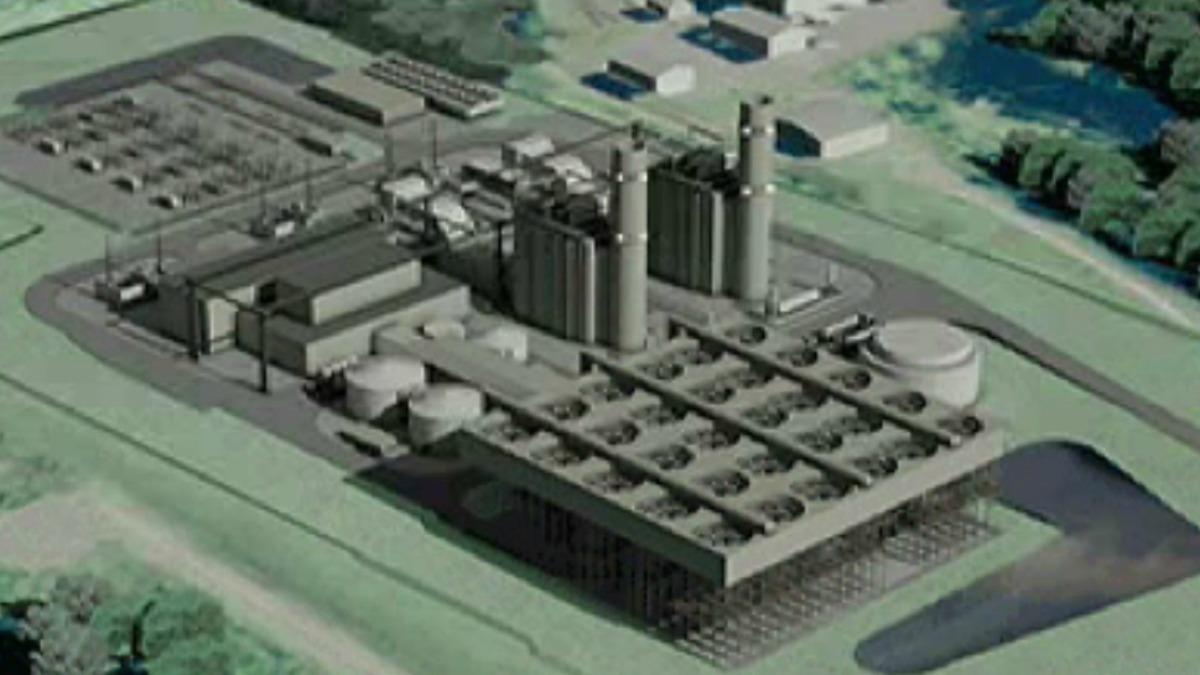
The proposed 805-megawatt power plant in Oxford is raising environmental concerns in the region.
The story is fairly simple; Oxford town officials are enthusiastic about the construction of a 805-megawatt power plant off Woodruff Hill Road that would provide a huge boost to the tax rolls in town, while surrounding communities (experiencing no economic benefit) are worried about nitrous oxide spewing out of smoke stacks, ground pollution, and millions of gallons of grey water being dumped into the Naugatuck River. The battle lines are a familiar story in America; money and industry versus the health and well being of the population and the environment.
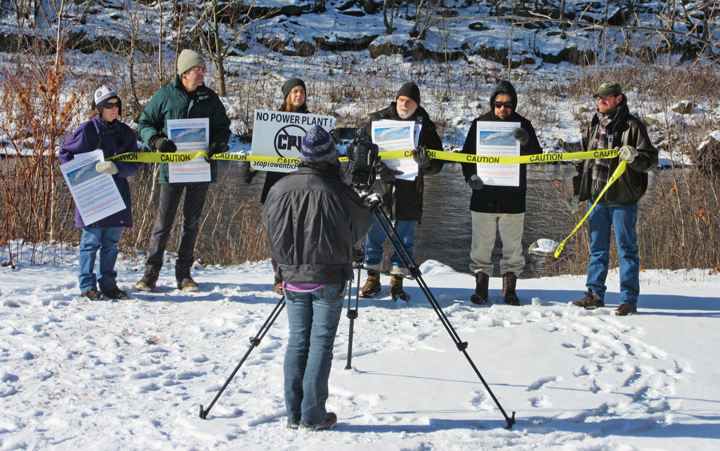
Protestors against the power plant held a rally in Linden Park in Naugatuck last weekend to draw attention to the environmental impact of the proposed power plant. Those protesting were members of the Naugatuck Environmental Network which included the Naugatuck Land Trust, the Committee for a Cultural/Environmental Center on Gunntown Road, and the Naugatuck River Revival Group.
This battle will play itself out in a Connecticut Siting Council that has the power to approve or deny Competitive Power Ventures attempt to build the facility in Oxford. A public hearings is scheduled for Thursday, January 15th, at Oxford High School, 1 Great Hill Road in Oxford.
The looming question for community leaders, elected officials and city residents in Waterbury is; so what? Why should we be concerned about what happens in Oxford?
Answer – the Naugatuck River, and the possible negative affect of hundreds of millions of gallons of grey water dumped into it.
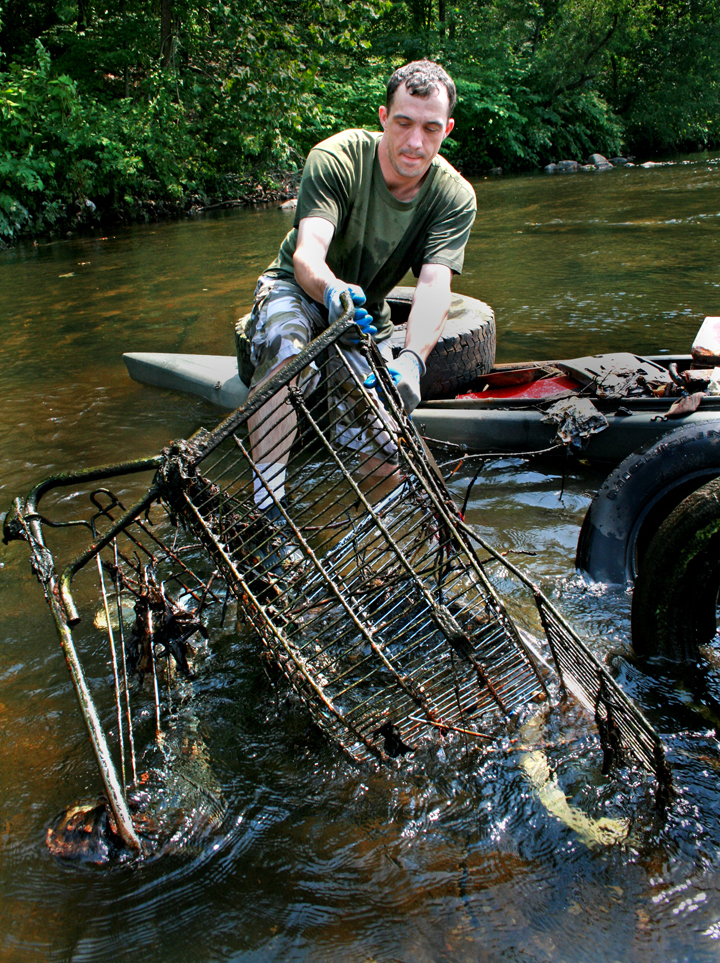
Dozens of clean-ups have been organized by the Naugatuck River Revival Group and tons of debris has been removed from the river.

The return of nesting osprey and bald eagles to the river have announced the health and vitalty of a river reborn. Photograph by Sondra Harmon
In the past two decades the Naugatuck River ecosystem has experienced an extraordinary rebirth with the return of bald eagles, osprey, beaver, mink, herons, foxes, coyotes, bobcats and black bears. For a river that used to flow red and green from industrial dyes, and actually caught fire once, this is a remarkable recovery. The resurgence has been so dramatic that the city has begun to build a seven-mile greenway trail that will bring city residents back to the edges of the river, back to where the community started in the 1670. Waterbury Mayor Neil O’Leary has leveraged the construction of the Naugatuck River Greenway project through the city into a massive WATER Project that would create a 17-acre park on the river and construct a new downtown area on Freight Street, smack on the river.

Waterbury is proposing to build a a 17-acre city park on the banks of the Naugatuck River. Migrating fish and wildlife might be adversely affected by the millions of gallons of grey water being dumped a few miles down the river. City officials should be closely monitoring the status of the grey water and how it migh affect the relationship of city residents to the river.
Environmental activist Kevin Zak has been cleaning the river for the past decade and has spent thousands of hours in and around the Naugatuck River documenting wildlife in the ecosystem. Zak is the president of the Naugatuck River Revival Group and the leading spokesperson for the river.
“Millions of dollars have been invested in the revival of the Naugatuck River since 1999,” Zak said. “And we need to pay close attention to what this power plant is proposing to do in dumping millions of gallons of hot grey water into this watershed.”
The water will be pumped out of the Pomparaug River and used to cool the turbines in the power plant. The water will then be piped and trucked to the Naugatuck Waste Water Treatment plant where it will be treated and released directly into the Naugatuck River.
“We are deeply concerned about the grey water coming from the power plant and whether the treatment plant in Naugatuck can remove metals and ammonia,” Zak said. “No one is paying attention to the end result of this process and it could be devastating to the Naugatuck River.”
Could be. Zak openly admits he has no exact data that proves that the grey water dumped into the watershed will be harmful, but he said that’s not his responsibility.
“The Naugatuck River Revival Group should not have the burden of proof,” Zak said. “The power plant needs to show they will do no harm to the river and the wildlife.”

Kayak races along the Naugatuck the past few years have added greater awareness to the vitalty of the river’s ecosystem.
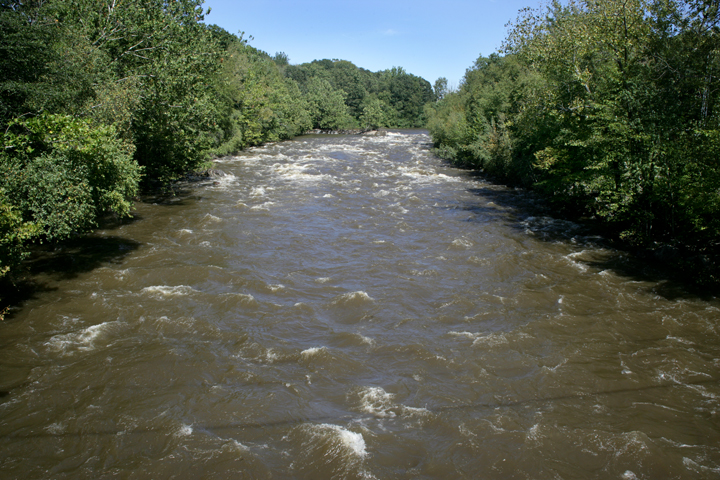
A day after a hurricane flooded the region the swollen Naugatuck River roared through the Platts Mill neighborhood.
And what exactly is grey water? One definition on the internet states, “Greywater is defined as wastewater generated from plates and wash-hand basins, showers and baths, which, because it is nearly as clean as potable water, can be recycled onsite for uses such as toilet flushing, landscape irrigation and constructed wetlands. Greywater often also includes wastewater from clothes washing machines and sometimes include discharge from dishwashers and kitchen sinks.”
The grey water from the Oxford power plant will not be generated from washing dishes, but from millions of gallons of Pomperaug River water used to cool turbines.
“I have spent hours and hours trying to get a handle on what grey water is,” Zak said, “and it is very confusing. That’s why we need the power plant to prove the grey water will do no harm to the ecosystem and to the economy. They are the ones planning on dumping millions of gallons of the stuff into the Naugtauck River. It would irresponsible to assume that everything coming out of the power plant is okay. Our mission is to shine a spotlight on this issue and to protect the Naugatuck River and the proposed economic development projects in Waterbury.”
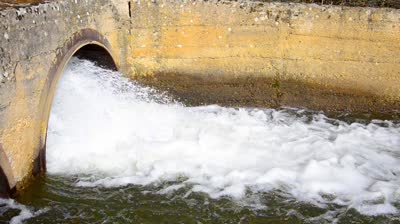
The mystery of what will be in millions of gallons of grey water has raised concerns for the health of the Naugatuck River watershed. Questions need to be answered.
Zak said an historical look at rivers in New England should give pause when considering the immediate impact of development versus the long-term implications.
“In the 1790s all the rivers were dammed and the settlers built mills, created jobs and built towns,” Zak said, “but no one put into the economic equation what would happen when the mills dried up and the rivers died. It was devastating. We need to look further down the road and consider what this power plant means to the future of the Naugatuck River.”
Zak and the Naugatuck River Revival Group are intervenors in the power plant approval process and will be providing testimony to the Connecticut Siting Council.
“The siting council is going to get a lesson about the Naugatuck River,” Zak said. “They are going to hear about what the river was, what it is, and what it will become.”
The Airport
Seven miles southeast of downtown Waterbury is Connecticut’s 2nd largest airport and despite its considerable size, and the fact that numerous airlines and other local businesses generate much – or all – of their business there, the airport usually doesn’t generate much discussion in Waterbury.
But over the last several years this airport has repeatedly been a point of direct attention from the U.S. Federal Aviation Administration (FAA). This is because in 1999, the Connecticut Siting Council granted approval for the construction of a power plant off Woodruff Hill Road in Oxford, in very close proximity to the airport.
Not long after the permit was issued, the FAA decided that a power plant in this location would be exceptionally hazardous to aircraft landing at or taking off from the airport. These concerns ultimately stymied the plant’s construction, and today, 15 years later, still no plant has been built. Consequently the original permit has now been sold five (5) times since it was first issued. The fifth and current owner of this permit is a Massachusetts-based company called Competitive Power Ventures Holdings LLC, shortened as CPV.
At some point in the late spring or early summer of 2014, CPV submitted an application to the Connecticut Siting Council for a modification to the original permit, asking permission to build an even bigger, 805-megawatt plant at the same location.
On September 11, U.S. Congresswoman Elizabeth Esty wrote to Middlebury First Selectman Ed St. John about her concern the plant would cause challenges to aircraft using the Waterbury-Oxford Airport. The letter was later posted to stoptowanticpower.com.
On November 17th, the FAA came out against this power plant as well – expressing renewed concern that the plant would present physical and electromagnetic hazards to aircraft taking off from or landing at the airport. However, in the document the FAA stated that if CPV would agree to change the plant’s design by shortening the plant’s cooling towers or “stacks” to be no more than 46 feet high, it would be in compliance with their standards.
Protesters gathered again on December 29th, at the Waterbury-Oxford Airport, alongside State Senator Joan Hartley, State Senator Joe Crisco, Middlebury First Selectman Ed St. John, former Oxford First Selectman Kathy Johnson and Southbury Selectman John Monteleone, as well as numerous pilots and airline business representatives, at what organizers called a pilot’s rally. This event was also covered by the local and state media.
With all this fuss raised about the airport, many locals are more concerned about the damage the plant would cause to the health of the community, region, and ecosystem. The Stop Towantic Power Committee says anyone within a 10-12 mile radius of the proposed plant’s location would be liable to suffer various adverse health effects from breathing and otherwise coming in contact with toxic soot, nitrous dioxide, methane, sulfur and uncombusted natural gas. The plant would also deposit hundreds of thousands of gallons of “grey water” (water that has been used to cool the turbines) each day into the Naugatuck River via the Naugatuck Wastewater Treatment Facility.
Waterburians should realize that whether this power plant is built or not strongly impacts the city’s future. On the pro side, a power plant would employ hundreds of local people and draw new people to the area. On the con side, a steady breeze of toxic air and flow of steaming hot grey water could jeapordize the health of the Naugatuck River (the central focus of the City’s WATER Project) and worsen the overall health of the city and its environment.
This power plant decision is not something that only affects Oxford. As the 9th largest city in New England, situated less than 10 miles away from the proposed plant’s site, Waterbury should hold a powerful position in the decision whether or not the plant ought to be built.
Is anyone paying attention?

